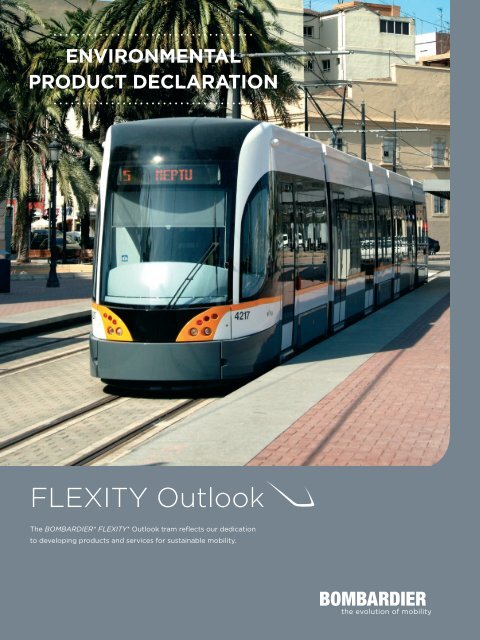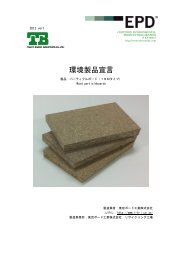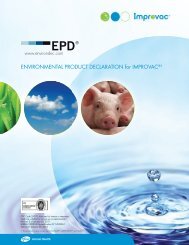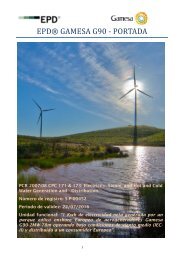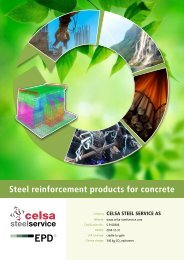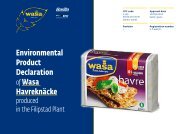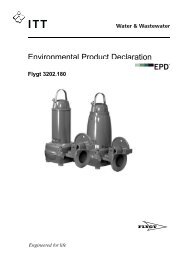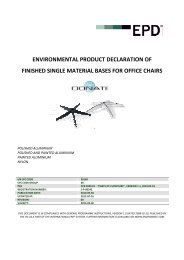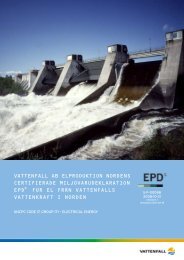EPD FLEXITY Outlook - Csr Bombardier
EPD FLEXITY Outlook - Csr Bombardier
EPD FLEXITY Outlook - Csr Bombardier
Create successful ePaper yourself
Turn your PDF publications into a flip-book with our unique Google optimized e-Paper software.
EnvironmentalProduct Declaration<strong>FLEXITY</strong> <strong>Outlook</strong>The BOMBARDIER* <strong>FLEXITY</strong>* <strong>Outlook</strong> tram reflects our dedicationto developing products and services for sustainable mobility.
<strong>FLEXITY</strong> <strong>Outlook</strong>Designed for Sustainable MobilityValenciaThe <strong>FLEXITY</strong> <strong>Outlook</strong> tram sets a high standard forenvironmentally sustainable rail transportation. ThisEnvironmental Product Declaration provides a detailedinsight into the environmental impact of the Valencia/Alicante <strong>FLEXITY</strong> <strong>Outlook</strong> tram throughout its completelife cycle.Communicating EnvironmentalPerformance – ISO 14025We communicate the environmental performance of ourproducts through Environmental Product Declarations(<strong>EPD</strong>s) following the international <strong>EPD</strong>® system. Our<strong>EPD</strong>s are developed in line with the UNIFE ProductCategory Rules for Rail Vehicles (PCR 2009:05) as wellas the principles and procedures of ISO 14025:2006.<strong>EPD</strong>s are part of the BOMBARDIER* ECO4* productportfolio. They are based on Life Cycle Assessmentmethodology and function as an externally validatedcommunication tool, providing complete transparency tothe benefit of our customers and other stakeholders.The external validation is carried out by independentverifiers approved by the technical committee of theinternational <strong>EPD</strong>® system and/or the EU Eco-managementand Audit Scheme (EMAS).The Valencia and Alicante configuration of the <strong>FLEXITY</strong><strong>Outlook</strong> tram forms the basis of the specific environmentalinformation of this <strong>EPD</strong>.<strong>FLEXITY</strong> <strong>Outlook</strong> Valencia/Alicante - Highlighted facts and figuresNumber of cars 5Weight (empty)CapacityMax speedEnergy consumption41 230 kg50 seats / 150 standing71 km/h3,7 kWh/kmRecoverability / Recyclability 98% / 92%Alicante2<strong>FLEXITY</strong> <strong>Outlook</strong> – Environmental Product Declaration
Material ContentEnergy EfficiencyThe <strong>FLEXITY</strong> <strong>Outlook</strong> tram is developed with a strongemphasis on our commitment to eliminating hazardoussubstances and related toxic emissions, providing a saferenvironment for our customers, passengers andemployees. The <strong>Bombardier</strong> Controlled Substances listenables product designers to screen out such substancesby identifying them throughout our supply chain andactively working towards eliminating them from our vehicles.Material [kg] Manufacturing Maintenance TotalMetals 33 928 17 054 50 982Polymers 1 614 460 2 073The projected energy consumption of 3,7 kWh/km isbased on a simulation run of the Valencia Linea 4operational profile. In order to consider stops betweenthe stations due to traffic lights and allow for varieddriving styles the simulation has been carried out inminimum driving time +20%. Assumptions on vehiclecomfort systems load is based on TecRec 100:001:Specification and verification of energy consumption forrailway rolling stock. The passenger load was consideredas 155 passengers, corresponding to an 80 % seatedoccupancy with 3 passengers/m 2 standing according toDIN 15663.Elastomers 610 532 1 142Glass 2 517 2 517Fluids 169 521 690MONM* 822 822Others 1 569 1 569Total (kg) 41 230 18 567 59 795The <strong>FLEXITY</strong> <strong>Outlook</strong> tram material composition and all materialrequired for maintenance during a 30 year operation. Materials areclassified according to ISO 22628:2002. *Modified organic naturalmaterialsThe following chart shows an allocation of the <strong>FLEXITY</strong><strong>Outlook</strong> tram total vehicle mass to the five mainproduct groups identified in PCR 2009:05, version 1.1 1 .Energy consumption (kWh/passenger-km)0,400,350,300,250,200,150,100,0500,03<strong>FLEXITY</strong><strong>Outlook</strong>0,08Bus(diesel)0,25car(diesel)0,36car(petrol)4%When compared to travelling by car or by bus the <strong>FLEXITY</strong> <strong>Outlook</strong>provides a far more energy efficient transportation solution.20%25%32%NoiseThe <strong>FLEXITY</strong> <strong>Outlook</strong> tram is homologated according to ISO3095, see limits shown in the table below. The limits fornoise are defined at a distance of 7,5 m from the centerof the track and 1,2 m above the top of the rail.19%NoisedB(A)Carbody 13 029 kgInterior, windows and doors 7 768 kgBogies and running gear 10 441 kgPropulsion and electric equipment 8 104 kgComfort systems 1 889 kgStandstill noise < 59Pass by noise < 821Product Category Rules (PCR) for preparing an EnvironmentalProduct Declaration (<strong>EPD</strong>) for Rail Vehicles, UNCPC CODE: 495,PCR 2009:05, version 1.1, International <strong>EPD</strong> Consortium (IEC).The Valencia <strong>FLEXITY</strong> <strong>Outlook</strong> tram modular structure accordingto PCR 2009:05, version 1.1.3
A Life Cycle PerspectiveEnvironmental Profile of the <strong>FLEXITY</strong> <strong>Outlook</strong>Raw material extractionManufacturing/Final assemblyEnd of lifeUseAt <strong>Bombardier</strong> life cycle thinking is integrated to thedesign process, highlighting the significance of differentdesign choices and the true overall environmentalimpact these choices have.Life Cycle AssessmentPower supplyElectric power to Valencia <strong>FLEXITY</strong> <strong>Outlook</strong> tram issourced primarily from hard coal and nuclear energy.The Spanish average power supply mix for 2011 wasused to model the operation phase of the Valencia<strong>FLEXITY</strong> <strong>Outlook</strong> tram life cycle.Resource efficiency, waste generation and overallenvironmental impact are estimated throughout all lifecycle phases of the Valencia <strong>FLEXITY</strong> <strong>Outlook</strong> tram,following ISO 14040:2006 methodology. 3 The study hasbeen carried out in cooperation with the ViennaUniversity of Technology. The results are based on theValencia <strong>FLEXITY</strong> <strong>Outlook</strong> tram in service for 30 years,with an average running distance of 60 000 km per year.All assumptions on vehicle comfort systems load arebased on TecRec 100:001: Specification and verification ofenergy consumption for railway rolling stock, followingthe methodology and operational profiles used for theenergy consumption simulation. The simulated operationalscenario features 50% energy recovery from regenerativebraking. The end of life phase of the life cycle is modeledaccording to technology available today. The potentialbenefit from material recycling and energy recovery isnot included in the environmental impact tables.2Rainer Pamminger, Life Cycle Assessment Report - <strong>FLEXITY</strong> <strong>Outlook</strong>Valencia, Vienna University of Technology, 201112%22%Hard coal6%Heavy fuel oilNatural gasNuclear energy2%20%27%Power supply for the Valencia <strong>FLEXITY</strong> <strong>Outlook</strong> tram resulting inemissions of 593 g of CO 2equivalents per kWh.3%8%Hydro powerWind powerBiomassOthers4<strong>FLEXITY</strong> <strong>Outlook</strong> – Environmental Product Declaration
Carbon FootprintEnergy and Material Resource UseGreenhouse gas (GHG) emissions throughout theValencia <strong>FLEXITY</strong> <strong>Outlook</strong> tram life cycle are 18,85 g ofCO 2equivalents per passenger travelling one km.Grams CO 2equivalents / passenger-km252017,47151051,070,290,020Renewable and non-renewable energy and materialresource use throughout the Valencia <strong>FLEXITY</strong> <strong>Outlook</strong>tram life cycle is detailed in the following charts as apercentage of the total for the entire life cycle of thevehicle. The distinction between renewable and nonrenewableenergy and material resources is shown withgreen shades representing renewable resources and greyshades representing non-renewable resources.2,98% 1,79% 1,19%4,48%11,5%Raw material extractionand component productionFinal assemblyUseEnd of life6,23%GHG emissions in g CO 2equ/passenger-kmRecyclability and RecoverabilityUsing materials featuring high recyclability and consideringdisassembly early in the design phase maximisethe overall recoverability of the Valencia <strong>FLEXITY</strong><strong>Outlook</strong> tram. Material recycling and energy recoveryaggregate to a 98% recoverability rate.Hydro powerBiomassUraniumHard coal14,12%Natural gasCrude oilBrown coalEnergy resource use throughout the Valencia <strong>FLEXITY</strong> <strong>Outlook</strong> lifecycle shown as a percentage of the total calorific value.6%2%0,03%0,08% 0,02%0,1% 0,02%92%12,06%Material recyclingEnergy recoveryResidues/DisposalWaterWoodGravelCalciteIronOthersProjected recoverability at the end of life phase of the Valencia<strong>FLEXITY</strong> <strong>Outlook</strong>, following ISO 22628 methodology.Material resource use throughout the Valencia <strong>FLEXITY</strong> <strong>Outlook</strong> lifecycle shown as a percentage of the total material resource mass.5
Environmental Impact in DetailRenewable resourcesUpstream moduleRaw material extractionand component productionCore moduleFinal assemblyMaterial (kg/passenger km) 8,20E-03 1,23E-02Water 9,01E-03 1,33E-03Wood 2,01E-05 3,25E-06Energy (MJ/passenger km) 1,41E-03 5,84E-04Hydro power 1,66E-03 5,77E-05Biomass 4,40E-04 4,72E-05Wind power 2,87E-05 4,10E-05Solar energy 4,14E-07 8,53E-07Non-renewable resourcesMaterial (kg/passenger km) 5,18E-03 4,09E-03Gravel 3,02E-04 4,03E-05Calcite 9,78E-05 4,32E-06Iron 1,66E-04 1,68E-06Others 1,38E-04 1,33E-06Energy (MJ/passenger km) 1,06E-02 1,17E-02Uranium 2,28E-03 8,68E-04Hard coal 6,97E-03 9,44E-04Natural gas 3,03E-03 2,02E-03Crude oil 4,18E-03 4,34E-04Brown coal 1,81E-03 1,51E-03WasteWaste (kg/passenger km) 6,61E-03 4,09E-03Hazardous waste 9,96E-05 9,12E-06Non-hazardous waste 2,91E-02 4,19E-02Environmental impact categories (pass.km)Acidification Potential (AP) [kg SO 2-Equiv.] 6,44E-06 4,56E-07Eutrophication Potential (EP) [kg Phosphate-Equiv.] 2,87E-06 8,37E-08Global Warming Potential (GWP 100 years) [kg CO 2-Equiv.] 1,07E-03 2,94E-04Ozone Layer Depletion Potential (ODP, steady state) [kg R11-Equiv.] 1,06E-09 3,27E-11Ozone Creation Potential (POCP) [kg Ethene-Equiv.] 4,36E-07 3,20E-076<strong>FLEXITY</strong> <strong>Outlook</strong> – Environmental Product Declaration
DefinitionsDownstream moduleTotalUseEnd of life3,68E-03 3,40E-04 2,45E-021,10E-01 3,19E-05 1,21E-017,81E-04 4,62E-08 8,05E-042,87E-01 8,64E-06 2,89E-011,61E-02 1,59E-06 1,79E-021,14E-02 6,82E-07 1,19E-027,71E-03 3,98E-07 7,78E-034,94E-05 3,12E-09 5,07E-055,34E-03 6,18E-05 1,47E-026,20E-04 4,18E-06 9,66E-041,61E-04 2,11E-07 2,64E-047,09E-05 1,26E-07 2,38E-046,89E-05 2,13E-07 2,09E-045,51E-03 1,84E-04 2,80E-021,08E-01 9,72E-06 1,11E-011,33E-01 1,06E-05 1,41E-015,72E-02 8,13E-06 6,23E-024,02E-02 4,53E-05 4,48E-022,64E-02 3,72E-06 2,98E-02Life cycle assessmentLife cycle assessment (LCA) is a technique assessing the environmentalimpact associated with all stages of a product’s life from-cradle-tograve(i.e., from raw material extraction through materials processing,manufacturing, distribution, use, repair and maintenance, and disposalor recycling).Acidification potentialThe aggregate measure of the acidifying potential of some substances,calculated through the conversion factor of sulphur oxides andnitrogen and ammonia into acidification equivalents (SO 2).Global warning potentialThe Global warning potential of a passenger travelling for one km isthe result of an allocation of the total amount of greenhouse gases(GHG) emitted over all phases of the vehicle life cycle. The total massof emitted GHGs is allocated to CO 2equivalents.Eutrophication potentialThe aggregate measure of the inland water eutrophication potentialof some substances, calculated through the conversion factor ofphosphorous and nitrogen compounds (waste water discharges andair emissions of NO xand NH 3) into phosphorous equivalents.Ozone layer depletion potentialThe aggregate measure of the ozone layer depleting potential of somesubstances, calculated through the conversion factor of halogenatedhydrocarbons that contribute to the depletion of the ozone layer intoCFC -11 equivalents.3,37E-03 7,79E-05 1,42E-021,90E-04 1,15E-07 2,99E-047,76E+00 4,01E-04 7,83E+00Photochemical ozone creation potentialThe aggregate measure of the ground level ozone creation potentialof some substances, calculated through the conversion factor ofethylene equivalents that contribute to the formation of photochemicaloxidants.1,68E-04 2,43E-08 1,75E-041,16E-05 7,29E-09 1,45E-051,75E-02 2,39E-05 1,89E-021,11E-09 5,71E-13 2,20E-092,35E-07 2,18E-09 9,05E-07Recyclability and recoverabilityThe recyclability and the recoverability rate of a new rail vehicle areexpressed as a percentage by mass of the rail vehicle that canpotentially be recycled, reused or both (recyclability rate), orrecovered, reused or both (recoverability rate).7


